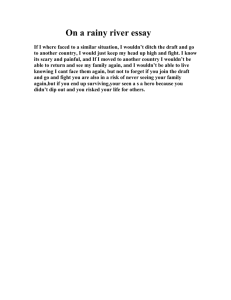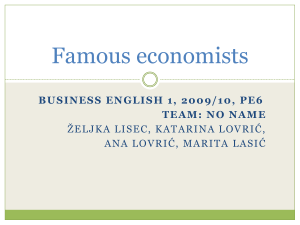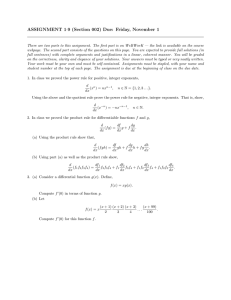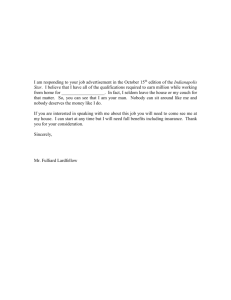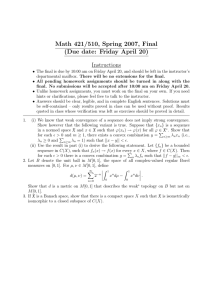1776 and All That: A Short Guide
advertisement
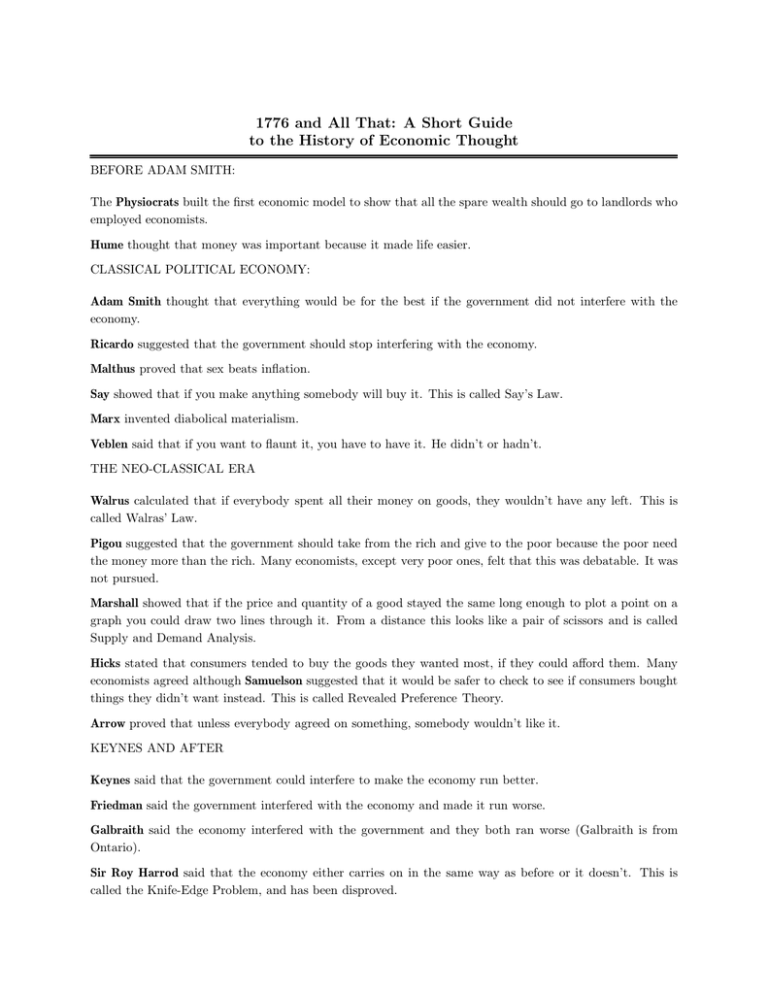
1776 and All That: A Short Guide to the History of Economic Thought BEFORE ADAM SMITH: The Physiocrats built the first economic model to show that all the spare wealth should go to landlords who employed economists. Hume thought that money was important because it made life easier. CLASSICAL POLITICAL ECONOMY: Adam Smith thought that everything would be for the best if the government did not interfere with the economy. Ricardo suggested that the government should stop interfering with the economy. Malthus proved that sex beats inflation. Say showed that if you make anything somebody will buy it. This is called Say’s Law. Marx invented diabolical materialism. Veblen said that if you want to flaunt it, you have to have it. He didn’t or hadn’t. THE NEO-CLASSICAL ERA Walrus calculated that if everybody spent all their money on goods, they wouldn’t have any left. This is called Walras’ Law. Pigou suggested that the government should take from the rich and give to the poor because the poor need the money more than the rich. Many economists, except very poor ones, felt that this was debatable. It was not pursued. Marshall showed that if the price and quantity of a good stayed the same long enough to plot a point on a graph you could draw two lines through it. From a distance this looks like a pair of scissors and is called Supply and Demand Analysis. Hicks stated that consumers tended to buy the goods they wanted most, if they could afford them. Many economists agreed although Samuelson suggested that it would be safer to check to see if consumers bought things they didn’t want instead. This is called Revealed Preference Theory. Arrow proved that unless everybody agreed on something, somebody wouldn’t like it. KEYNES AND AFTER Keynes said that the government could interfere to make the economy run better. Friedman said the government interfered with the economy and made it run worse. Galbraith said the economy interfered with the government and they both ran worse (Galbraith is from Ontario). Sir Roy Harrod said that the economy either carries on in the same way as before or it doesn’t. This is called the Knife-Edge Problem, and has been disproved. Rawls believed that if nobody knew what he was doing garbage collectors would probably be paid more money. this is called Social Justice. THE CHICAGO SCHOOL Lucas said you can’t fool all of the people all of the time. Coase showed that if nobody could break the law, then the law wouldn’t matter. This is called the Coase theorem. Stigler noticed that cars sold for different prices, while Alchian observed that people sometimes line up. Stigler got the Nobel prize. Cheung proved that if nobody could break the contract, then contracts wouldn’t matter. He wanted to call this Cheung’s theorem. Becker noted that it didn’t matter what good you place on the quantity axis of a supply and demand graph. Buchanan said that the government and the economy interfered with each other and neither could be made better or worse. MODERN ECONOMISTS Ackerlof discovered that new cars are better on average than used cars, while Spence argued university graduates don’t know anything. McClosky said there are no $500 bills on sidewalks ... and he/she said it very nicely. Merton and Scholes found a way to find $5 bills on the sidewalk, and quickly lost $4.2 billion. Fogel showed that if railroads had never been invented, no one would have noticed. North proved that pirates were bad, and getting rid of them was good. Barzel showed that if customer’s squeezed oranges hard enough it was bad for the oranges, and sellers would try to stop it. Allais proved you could win a Nobel prize with just a few numbers.
